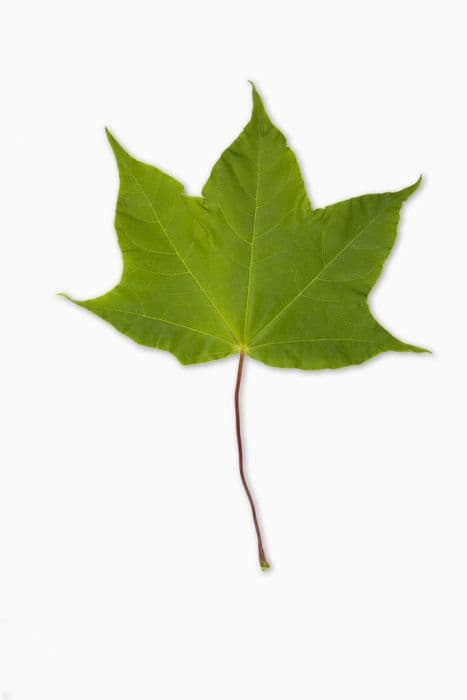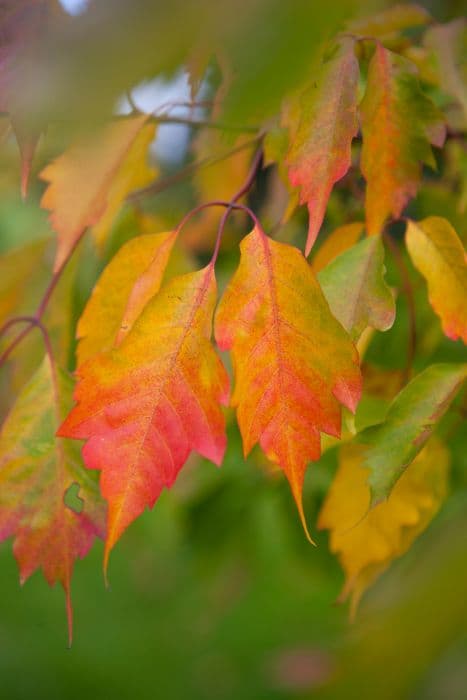Japanese Maple Acer palmatum 'Beni-maiko' (P)

ABOUT
The Japanese Maple 'Beni-maiko' is known for its captivating and vibrant foliage. This plant has leaves that start out a bright red in spring. As they mature, the leaves on this Japanese Maple transform into a deeper, fiery red hue that's slightly translucent, resulting in a stunning light show when backlit by the sun. The finely dissected leaves are delicate in appearance, giving the plant a feathery, soft look. Each leaf is divided into several lobes, resembling an open hand with fingers, which is characteristic of this type of Japanese Maple. In the fall, the leaves put on yet another color performance, shifting to a vivid red that provides a striking contrast to the often-muted tones of autumn. The bark of the 'Beni-maiko' Japanese Maple is smooth, contributing an additional layer of subtle beauty to this ornamental plant. Its overall form is rounded and bush-like, with a branching pattern that is open and allows for light to penetrate, creating a dappled shade beneath. This plant is a showstopper for its foliage and picturesque growth habit, which provides year-round visual interest in garden settings.
About this plant
 Names
NamesFamily
Sapindaceae
Synonyms
Japanese Maple, Red Dancing Girl Maple
Common names
Acer palmatum 'Beni-maiko'
 Toxicity
ToxicityTo humans
The Japanese Maple is generally considered non-toxic to humans. There are no significant reports of poisoning or toxic effects from ingesting any part of the Japanese Maple. Therefore, no symptoms of poisoning are typically associated with this plant.
To pets
The Japanese Maple is also generally considered non-toxic to pets. It is not known to cause any serious illness or symptoms of poisoning in animals like cats and dogs if they ingest parts of the plant. However, as with any non-food plant material, ingestion can potentially result in mild gastrointestinal upset.
 Characteristics
CharacteristicsLife cycle
Perennials
Foliage type
Deciduous
Color of leaves
Mixed
Height
6 feet (1.8 meters)
Spread
5 feet (1.5 meters)
Plant type
Tree
Hardiness zones
5-9
Native area
Japan
Benefits
 General Benefits
General Benefits- Ornamental Value: The Japanese Maple, specifically 'Beni-maiko', is praised for its striking red foliage, which adds aesthetic appeal to gardens and landscapes.
- Seasonal Interest: It provides year-round visual interest with its changing leaf colors throughout the seasons—bright red in spring, deeper tones in summer, and fiery hues in fall.
- Shade Tolerance: This variety tolerates shade well, making it suitable for planting under larger trees or in partially shaded areas.
- Compact Size: Its smaller stature makes it ideal for use in residential landscapes, including small yards and gardens.
- Minimal Maintenance: Once established, the Japanese Maple requires relatively low maintenance, needing only occasional pruning and watering during dry periods.
- Versatility in Landscape Design: The tree can be featured as a specimen plant, used in group plantings, or incorporated into border and foundation plantings.
- Cultural Significance: It holds a significant place in Japanese culture and garden design, making it an excellent choice for Japanese-themed gardens.
- Habitat Support: The tree provides habitat and shelter for birds and other wildlife within its branches.
- Non-Invasive Roots: The root system is typically non-invasive, making it a safe choice to plant near walkways, patios, and structures.
- Bonsai Suitability: 'Beni-maiko' can be trained as a bonsai, offering enthusiasts a beautiful and traditional species for this ancient art form.
 Medical Properties
Medical PropertiesThis plant is not used for medical purposes.
 Air-purifying Qualities
Air-purifying QualitiesThis plant is not specifically known for air purifying qualities.
 Other Uses
Other Uses- Acer palmatum 'Beni-maiko', commonly known as Japanese Maple, can be used as a bonsai specimen due to its attractive foliage and the ability to be trained into miniature forms.
- The wood of Japanese Maple is sometimes utilized in the creation of small, decorative woodwork projects like jewelry boxes, due to its fine texture and workability.
- The leaves of Japanese Maple can be pressed and preserved for use in craft projects such as resin jewelry, bookmark making or in custom stationary designs.
- Japanese Maple is often used in landscape photography as a focal point because of its striking red leaves, especially during the fall season.
- In a garden setting, Japanese Maple can be planted to create natural shade for smaller shade-loving plants that require protection from direct sunlight.
- The tree serves as an inspiration to artists and is often depicted in paintings and digital art, capturing the beauty of its foliage and form.
- Juvenile branches of Japanese Maple may be harvested and used in floral arrangements to add height and a touch of crimson color.
- The structure of Japanese Maple can be incorporated into garden designs that aim to mimic natural or miniature landscapes, often found in traditional Japanese gardens.
- The fallen leaves of the Japanese Maple can be used to create natural mulch for garden beds, providing nutrients to the soil as they decompose.
- Acer palmatum ‘Beni-maiko’ is planted in larger pots and used as a patio or deck plant to add an element of sophisticated foliage color in outdoor living spaces.
Interesting Facts
 Feng Shui
Feng ShuiThe Japanese Maple can be utilized in Feng Shui to bring in nurturing, supportive energy, due to its finely divided leaves and soft foliage that can enhance the flow of chi. Its red leaves are particularly useful in the Fame area of the Bagua to invite recognition and social success, or in the Wealth area to represent growth and prosperity.
 Zodiac Sign Compitability
Zodiac Sign CompitabilityThe Japanese Maple is not used in astrology practice.
 Plant Symbolism
Plant Symbolism- Beauty: Acer palmatum 'Beni-maiko', commonly known as Japanese Maple, often symbolizes beauty due to its delicate leaves and striking color, especially in the spring when the new leaves are a vibrant red.
- Peace: In Japanese culture, the maple tree is a symbol of peace and serenity, and the calming presence of the Japanese Maple in gardens is believed to bring tranquility.
- Grace: The tree's elegant form and the gentle way its leaves move in the breeze represent grace and elegance.
- Endurance: Despite its delicate appearance, the Japanese Maple is quite hardy, symbolizing endurance and the ability to withstand challenges.
- Balance: With its finely cut leaves and balanced shape, the Japanese Maple also represents balance, reminding those who contemplate it of the importance of harmony in life.
 Water
WaterThe Japanese Maple requires consistent moisture and should be watered deeply once or twice a week, depending on weather conditions. In hot or windy weather, it might need watering more frequently. Provide approximately 10 to 15 gallons of water each session for mature trees, ensuring it penetrates the soil well without causing waterlogging. Reduce the amount of water during the dormant season to avoid root rot. The goal is to maintain evenly moist soil, not wet or dry to the touch.
 Light
LightJapanese Maples thrive in a spot that offers full sun to partial shade. The ideal location would allow for morning sunlight and afternoon shade, particularly in hotter climates to prevent leaf scorch. A spot that gets dappled sunlight throughout the day is also beneficial for the delicate foliage of the 'Beni-maiko'.
 Temperature
TemperatureJapanese Maples are hardy but prefer a temperature range between 60°F and 80°F for optimal growth. They can withstand a minimum temperature down to about -20°F once fully acclimated. It's crucial to protect the 'Beni-maiko' from extreme heat, as temperatures consistently above 90°F can damage the plant.
 Pruning
PruningPruning the Japanese Maple is mainly for aesthetic shaping and to remove dead or damaged wood, enhancing its natural form. The best time to prune is late fall to mid-winter when the tree is dormant. Light pruning can be done annually, but a more thorough shaping should be done sparingly, as the tree responds best to minimal interference.
 Cleaning
CleaningAs needed
 Soil
SoilThe Japanese Maple 'Beni-maiko' thrives best in a soil mix consisting of well-draining potting soil, peat moss, and perlite to ensure a slightly acidic to neutral pH between 5.5 to 7.5.
 Repotting
RepottingJapanese Maple 'Beni-maiko' should be repotted every 2-3 years to replenish the soil and allow room for root growth, doing so in early spring before new leaves emerge.
 Humidity & Misting
Humidity & MistingJapanese Maple 'Beni-maiko' prefers average humidity levels, but can tolerate a range; it is generally not a high-humidity demanding plant.
 Suitable locations
Suitable locationsIndoor
Ensure bright indirect light, cool temperatures, and moist air.
Outdoor
Plant in partial shade, protect from harsh sun and winds.
Hardiness zone
5-8 USDA
 Life cycle
Life cycleThe life cycle of Acer palmatum 'Beni-maiko', commonly known as the Japanese Maple 'Beni-maiko', begins with seed germination, which occurs when soil temperatures warm up in spring. Following germination, the seedling emerges and establishes its root system while producing its first leaves. As a young sapling, the 'Beni-maiko' experiences steady growth and increased branching, developing its characteristic delicate foliage that changes color with the seasons. Over the years, it matures into an adult tree, where it reaches its full height, spreads its canopy, and becomes capable of producing flowers that lead to the formation of seeds. The adult tree goes through annual cycles of growth, producing new leaves in the spring that turn from pink-red to green in summer and crimson in fall before shedding to prepare for winter dormancy. This cycle continues for the tree's lifespan, which, with proper care, can extend over several decades.
 Propogation
PropogationPropogation time
Early spring
The Japanese Maple 'Beni-maiko' is typically propagated using grafting methods. Grafting is a process where a section of stem from the 'Beni-maiko' with leaf buds is inserted into the stock of another maple that has a robust root system. The best time for grafting this variety of Japanese Maple is in late winter before spring growth begins, ensuring that the sap is not actively flowing. The scion wood, which is a portion of the plant that is grafted onto the rootstock, should be dormant and collected from the desired 'Beni-maiko' when temperatures are cold. The graft union must be wrapped and sealed to prevent drying and infection, with materials like grafting tape or wax. Over time, as the graft heals, the scion will begin to grow and develop into a new 'Beni-maiko' tree, genetically identical to the parent plant. This method is favored for Japanese Maples due to its effectiveness in reproducing exact replicas of the parent plant's characteristics.









